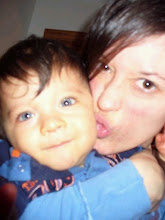Wow, how time does fly. It’s funny how motherhood changes, yet stays the same in 8 months. My mothering style is the same, Caden is still a great kid, but the challenges and accomplishments are so different. Where Caden used to say, “No, no like it,” about going to daycare, he is now able to say, “I don’t want to go to Lori’s.” He also has increased strength and speed, so getting him ready in the morning can be a challenge.
Yet, I still believe in “gentle mothering,” and putting myself in his shoes. A great example of this is computer usage. Caden has a computer game and really enjoys playing it. When it’s time for dinner, I give him 5 minutes to finish up, rather than demand that he come up immediately when I call him (I mean, come on – if Ryan demanded me to drop everything at his beck and call, I would be upset too). Usually, Caden finishes up and does what I asked without problems. Sometimes he needs a little extra direction, but he definitely understands the concept of doing certain activities in a certain order.
As a firm believer in natural health (http://www.examiner.com/x-9302-Minneapolis-Natural-Health-Examiner), I find these beliefs to be creeping into my mothering habits. Specifically in our diets with hormone free milk and grass fed beef (I highly recommend watching Food, Inc. or reading the Omnivore’s Dilemma by Michael Pollan), but also retrospectively in childbirth and baby care. I recently read an article about parabens and how they are found in the urine minutes after applying a topical cream (http://featuresblogs.chicagotribune.com/features_julieshealthclub/2007/09/should-you-go-p.html).
I was also very excited to see many of my friends become new mothers or pregnant this year. It has made me reflect on my own experiences in pregnancy and birth, and how they have changed my opinion of modern medicine’s involvement in a process that is nearly as old as life itself (because the chicken came before the egg).
I was a week overdue with Caden and was so impatient and anxious that I wanted to get things going, rather than wait for nature’s perfect timing. I also wanted a natural childbirth, and by having my membranes ruptured, I already started the process out unnaturally. And so began 48 hours of labor, ending with an epidural, a tear and a forceps delivery. In retrospect, Caden hadn’t yet positioned himself for optimal delivery (most babies are delivered face down, some are delivered face up, but Caden was completely sideways). Had I waited, perhaps things would have gone differently. Or perhaps not. I’m not an expert, I only know that the next time around (if there is a next time), I will be patient and wait for my baby and body to decide when to deliver.
Nowadays, a woman’s odds of getting a C-section double when she enters the hospital for delivery. With medical advances, C-sections are getting to be easier on mothers (to the point where they can still be awake to greet their babies), but it is still a surgery, which results in a longer recovery time and other surgical risks. It stands to reason that these C-sections may also be increasing with the number of scheduled inductions.
I simply wish that the medical community wasn’t so focused on technology when a simple natural process often does the job just as well. As an employee in the biotech field, I see that technological advances are being developed every day for problems that are created by our fast-paced, technology-driven society. We develop stents for heart disease, which could be prevented for many people with diet and exercise – but a good diet is increasingly difficult to eat in popular culture, and we have technology to prevent us from needing to exercise (cars, snowblowers, etc).
Whew, now I see why I like blogging so much better than writing for my column – I can take the liberty to wander from my main point.
In sum, I am glad technology is there for people who need it. Stents save people who would have heart disease even if they led a healthy lifestyle. C-sections save women who might otherwise have died in childbirth. But these technologies need not be the rule, the first place people turn. An ounce of prevention is worth a pound of cure, and it saves a lot of money in health care costs as well. By paying attention to the positioning of the baby, by waiting for the baby to come (basically midwifery at its finest), women can avoid unnecessary interventions that don’t necessarily endanger their lives, but are costly and potentially lead to a longer recovery time and other undesirable side-effects.
Thursday, December 17, 2009
Gentle mothering and childbirth
Labels:
c-section,
childbirht,
induction,
natural childbirth,
natural mothering
Subscribe to:
Post Comments (Atom)

No comments:
Post a Comment